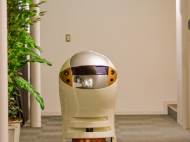ii-2 guide robot used for verbal Q&A tasks
 Professor Hirotaka Nakayama and his students at Kobe’s Konan University Faculty of Intelligence and Informatics have created a guide robot called ii-1. It is able to perform Q&A tasks by using natural language for communication and querying an internet database to find the answers to asked questions. The project began in 2008 when four of the newly formed research departments with backgrounds in image processing, artificial intelligence, and natural language processing began working together to create a robot that could illustrate what the school’s research is about, during prospective students’ “open campus” days.
Professor Hirotaka Nakayama and his students at Kobe’s Konan University Faculty of Intelligence and Informatics have created a guide robot called ii-1. It is able to perform Q&A tasks by using natural language for communication and querying an internet database to find the answers to asked questions. The project began in 2008 when four of the newly formed research departments with backgrounds in image processing, artificial intelligence, and natural language processing began working together to create a robot that could illustrate what the school’s research is about, during prospective students’ “open campus” days.
When asked a question, ii-1 connects to a campus website where it queries the database using keywords to find relevant material which it then uses to respond with open source speech synthesis software Julius. The system can answer simple “yes” and “no” questions but is special in that it can also handle “who” and “why” questions by analyzing the relationship between words. It can also move (painfully slow in the demo videos) around on mobile platform based on MOBILEROBOTS Pioneer3-DX, and avoid obstacles with its built-in Hokuyo laser range sensor.
The robot is 100cm tall and weights 40kg. Its body features a curvaceous design fabricated in an ABS epoxy, which, although aimed to be amiable as R2-D2, reminds of modern trash cans (ironically there are some behind the robot in the video bellow). The designers from Artlabo could try to make something more appealing and contemporary. The robot communicates with its built-in speakers and two OLED displays (capable to show textual information or graphics representing the robot’s eyes).
In the future, they plan to implement facial expression recognition in order to enhance the robot’s interactive functionality. That way, they plan to use its development for future general conversation between robots and humans, conversation between robots, and companionship with humans after recognizing facial expressions.
Why do we need Q&A robots when we could use such algorithms on our mobile phones? Besides the fact almost everyone has one, and the convenience they can connect to the networks inside buildings. they can serve more individuals in the same time. The further development of this robot should be focused on its ability to communicate and understand our needs, thus making it a robotic aid for elderly or disabled people.









Leave your response!